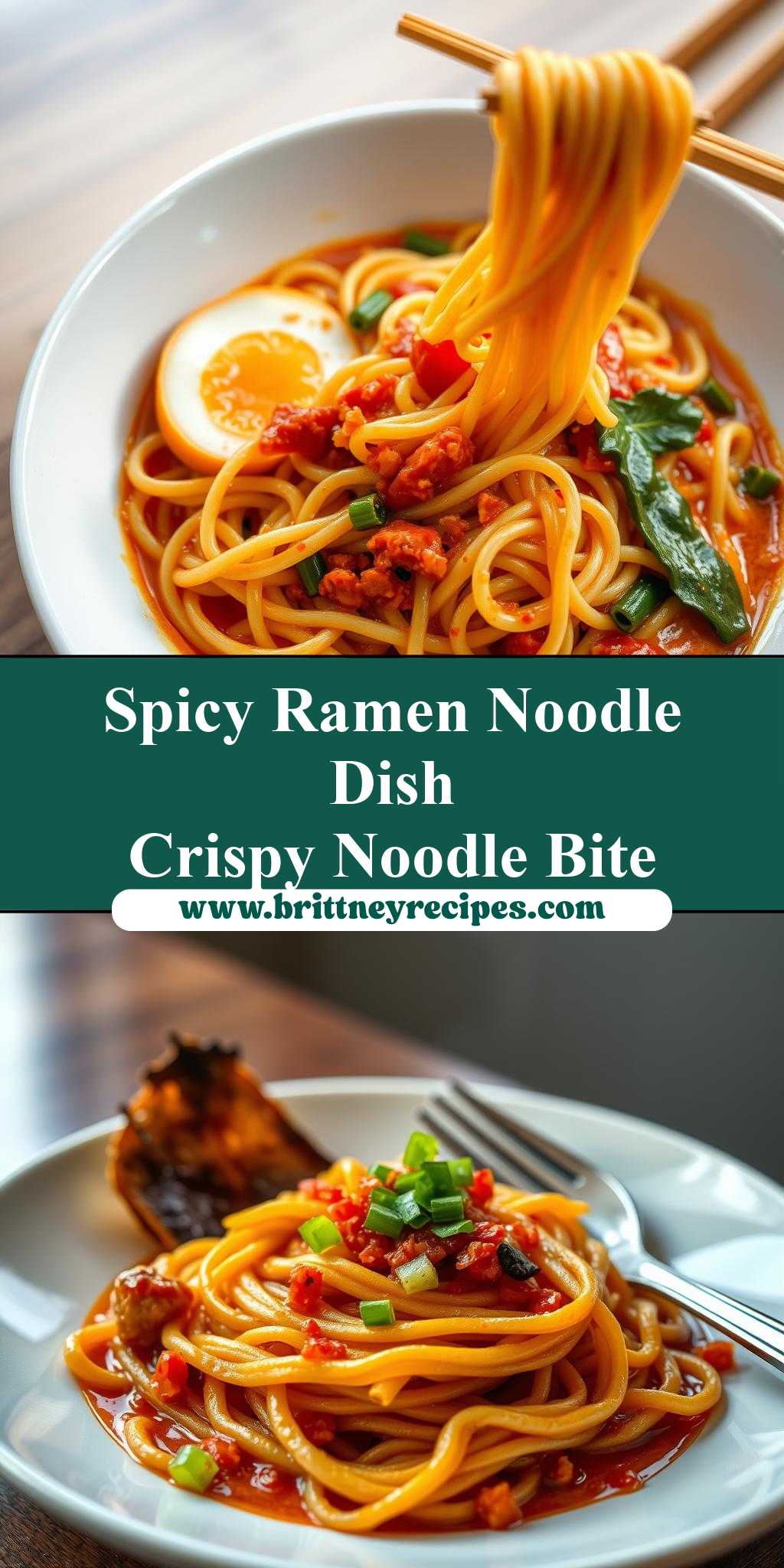What makes the perfect bowl of Spicy Ramen Noodles so addictive? For me, it’s all about rich pork broth, springy homemade noodles, and a kick of heat from fresh chili flakes. This easy weeknight dinner recipe is a quick fix for a busy evening, made with simple ingredients and a whole lot of flavor. Save this idea for a cozy night in and try it soon with your family for a new favorite meal.
Spicy Ramen Noodles
Introduction
Indulge in the vibrant flavors of Asia with our delectable Spicy Ramen Noodles recipe, a dish that masterfully balances ease, flavor, and creativity using everyday ingredients. This recipe is perfect for those who crave a spicy kick and a satisfying meal without the hassle of complicated preparations. With its rich, savory broth, springy noodles, and an array of colorful toppings, Spicy Ramen Noodles is not just a meal, but an experience. Whether you’re a seasoned foodie or a curious beginner, this dish promises to delight your senses and leave you wanting more.
Why This Works
- Flavor balance and ingredient accessibility: This recipe strikes a perfect balance between spicy, sour, sweet, and umami flavors, using ingredients that are readily available in most supermarkets.
- Ease of preparation: The steps are straightforward and simple, making it accessible to cooks of all skill levels. You can have a steaming bowl of Spicy Ramen Noodles ready in under 30 minutes.
- Impressive results with minimal effort: The combination of store-bought ramen noodles with a homemade broth and various toppings allows for a quick preparation time without sacrificing flavor or presentation.
Key Ingredients
The foundation of Spicy Ramen Noodles includes ramen noodles, a spicy broth made with chicken or vegetable stock, soy sauce, sesame oil, and your choice of protein such as chicken, beef, or tofu. For added flavor and texture, consider including a variety of vegetables like mushrooms, bell peppers, and green onions, along with boiled eggs and pickled ginger. Practical substitutions can be made based on dietary preferences and ingredient availability. For instance, you can use gluten-free soy sauce for those with gluten intolerance or swap chicken with tofu for a vegan option.
Instructions
- Step 1: Begin by preparing your ingredients. Chop the vegetables, slice the protein into thin strips, and boil eggs until they’re cooked through. If using, slice the green onions and pickled ginger for garnish.
- Step 2: Cook the ramen noodles according to the package instructions and set them aside. In a large pot, combine the broth ingredients, including stock, soy sauce, and sesame oil, and bring to a simmer. Add your choice of protein and cook until it’s fully cooked, then remove it from the broth and set it aside.
- Step 3: Add the sliced vegetables to the broth and cook until they’re tender but still crisp. This step is crucial for maintaining the texture and freshness of the dish. For an extra spicy kick, you can add red pepper flakes or sliced jalapeños to the broth.
- Step 4: To assemble the Spicy Ramen Noodles, place the cooked noodles into a bowl, add sliced protein on top, followed by a variety of vegetables and a spoonful of the spicy broth. Garnish with green onions, pickled ginger, and a soft-boiled egg. Feel free to customize with your favorite toppings for a personalized flavor experience.
Handy Tips
- For a clearer broth, skim off any impurities that rise to the surface after it’s been simmering for a while. This simple step can greatly enhance the appearance and quality of your dish.
- Consider making your broth ahead of time and refrigerating or freezing it for later use. This not only saves time but also allows the flavors to meld together more intensely.
- Experiment with different types of noodles and broths to find your perfect combination. Some might prefer a heartier, chewier noodle, while others might enjoy a lighter, more delicate broth.
Heat Control
When cooking the broth and protein, it’s essential to maintain a gentle simmer. This ensures that the flavors are extracted slowly and that the protein cooks evenly without becoming tough. For the ideal temperature, aim for a simmer around 180°F to 190°F (82°C to 88°C). Cooking time will vary depending on the protein and vegetables used, but as a general rule, cook until the protein is fully cooked through and the vegetables are tender but still retain some crunch.
Crunch Factor
Achieving the right texture in Spicy Ramen Noodles is key to its appeal. The noodles should be springy, the vegetables crisp, and the toppings add a satisfying crunch. By not overcooking the noodles and vegetables, you can preserve their natural texture. Additional crunch can be added with toppings like toasted sesame seeds, crispy garlic, or pickled vegetables.
Pro Kitchen Tricks
- Use a mixture of soy sauce and sesame oil to marinate your protein before cooking for enhanced flavor.
- For an intense umami flavor, add a teaspoon of mushroom paste or dried mushrooms to the broth.
- To save time on cleanup, prepare all ingredients in a systematic order, and wash utensils and pots as you go to prevent clutter and food from drying onto them.
Storage Tips
- Leftover broth and cooked noodles can be stored separately in the refrigerator for up to 3 days. Reheat the broth and cook fresh noodles when you’re ready for another meal.
- For longer storage, consider freezing the broth in ice cube trays for easy portioning later. Cooked noodles can become mushy when frozen, so it’s best to cook them fresh each time.
- Use airtight, microwave-safe containers for reheating leftovers to prevent spills and ensure even heating.
Gift Packaging Ideas
While Spicy Ramen Noodles is typically enjoyed fresh, components of the dish can be gift-packaged for a unique and thoughtful present. Consider filling mason jars with homemade broth concentrate, pickled ginger, or spicy sesame oil. Decorate the jars with ribbons or labels and include a packet of ramen noodles and a recipe card for a complete gift. This is a wonderful way to share the joy of cooking and the warmth of a homemade meal with friends and family.
Flavor Variations
- Different spices: Experiment with various spice blends like Korean chili flakes (gochugaru) for an intense heat or Chinese five-spice for a more complex flavor profile.
- Creative toppings: Add some luxury with truffle oil, a sprinkle of grated truffle, or a slice of seared foie gras for special occasions.
- Ingredient swaps: Substitute chicken with shrimp for a seafood version or use a variety of mushrooms for a vegetarian option. The versatility of Spicy Ramen Noodles allows for countless adaptations to suit any taste or dietary requirement.
Troubleshooting
- Texture problems: Overcooked noodles can become mushy. To avoid this, cook them al dente and rinse with cold water to stop the cooking process.
- Ingredient replacements: If a specific ingredient is not available, look for substitutes that offer similar flavor profiles. For instance, tamari can replace soy sauce for a gluten-free option.
- Over/undercooking signs: Check your protein and vegetables frequently to avoid overcooking. A perfectly cooked dish should have protein that’s fully cooked through and vegetables that retain some crunch.
FAQs
- Can I freeze it? Yes, the broth can be frozen, but it’s best to cook noodles fresh for the best texture.
- Is it gluten-free? It can be, by using gluten-free soy sauce or tamari and ensuring all other ingredients are gluten-free.
- Can I double the recipe? Absolutely, this recipe scales well. Just ensure you have a large enough pot to accommodate the increased volume of broth and ingredients.
Conclusion
Spicy Ramen Noodles is a culinary adventure that invites you to explore the depths of flavor and texture with each spoonful. With its accessible ingredients, straightforward preparation, and endless possibilities for customization, this dish is sure to become a staple in your kitchen. Whether you’re cooking for one or feeding a crowd, the joy of Spicy Ramen Noodles lies in its ability to bring people together over a shared love of good food and warm, comforting meals. So go ahead, get creative, and make this recipe your own. Share your variations, tips, and stories, and let’s celebrate the universal language of food that unites us all.

